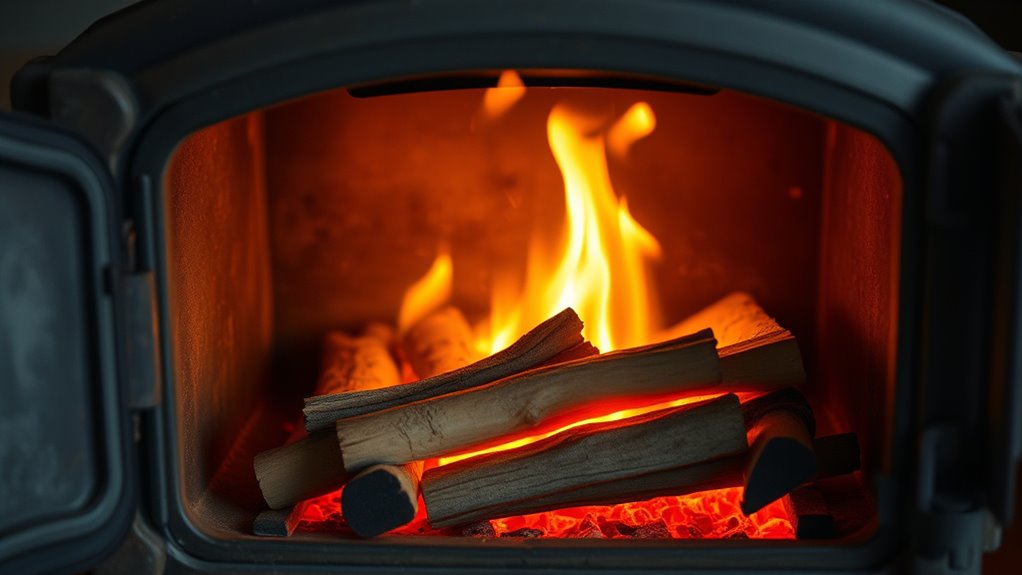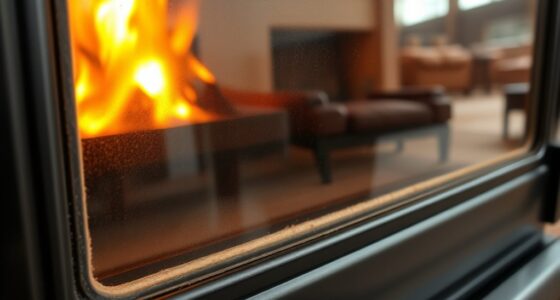To start a fire in your wood stove, first gather all your supplies like seasoned firewood, kindling, fire starters, and safety gear. Clean out ash and check vents and chimney for blockages. Arrange the firewood properly, placing smaller logs and kindling on top of larger ones, then ignite the fire starter at the base. Regulate airflow with dampers to keep the fire burning efficiently. Keep safety in mind, and you’ll soon master a clean, warm fire—you’ll find out how step by step.
Key Takeaways
- Prepare the stove by cleaning, checking door seals, vents, and chimney for safety and airflow.
- Use dry, seasoned hardwood with kindling and fire starters for easy ignition.
- Arrange logs with larger pieces at the bottom and smaller ones or kindling above, leaving space for oxygen.
- Light the fire from the bottom using fire starters, ensuring proper ventilation and airflow.
- Regulate airflow with dampers or vents to control the burn and maintain safety while the fire establishes.
Preparing Your Wood Stove and Supplies
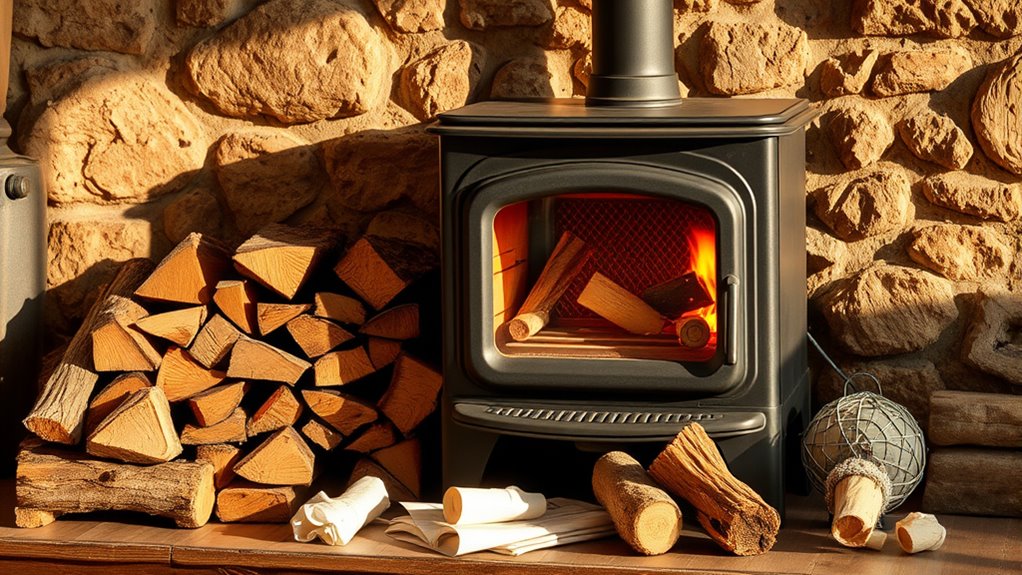
Before you start a fire, it’s important to make certain your wood stove and supplies are properly prepared. Gather essential fireplace accessories like a poker, ash shovel, and fireproof gloves to handle the fire safely. Clear out any existing ash and ensure the stove’s interior is clean to promote good airflow. Check that the door seals tightly and that vents are unobstructed. Always follow safety precautions, such as keeping a fire extinguisher nearby and ensuring there’s adequate ventilation. Inspect your chimney and stovepipe for blockages or creosote buildup. Proper fireplace maintenance not only helps your fire burn efficiently but also reduces the risk of accidents. Incorporating automation technologies into routine maintenance can also improve safety monitoring. For example, installing sensor-based monitoring systems can alert you to potential issues before they become serious. Additionally, regular chimney inspections are essential to prevent dangerous creosote buildup and ensure safe operation. Regularly checking for ventilation efficiency can help maintain optimal airflow and safety. Taking these steps guarantees a safe, successful start to your cozy fire.
Choosing the Right Firewood
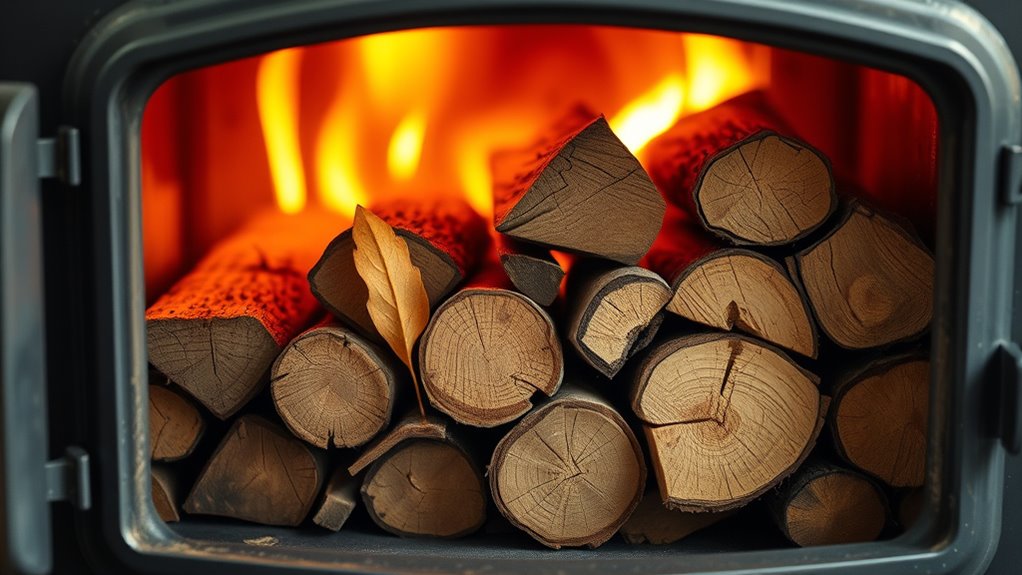
Choosing the right firewood is vital for a safe, efficient, and clean-burning fire. You want to select the best types of firewood, such as hardwoods like oak, maple, or hickory, which produce more heat and burn longer. Softwoods, like pine or spruce, ignite quickly but tend to burn faster and produce more creosote, so use them for kindling or quick fires. Proper firewood storage is essential; keep your wood in a dry, ventilated area off the ground to guarantee it’s well-seasoned. Well-stored firewood reduces moisture content, making it easier to light and burn efficiently. Always choose dry, seasoned wood over green or wet wood to minimize smoke, creosote buildup, and pollution, resulting in a safer, cleaner fire. Additionally, understanding Firewood Selection can help you optimize your heating efficiency and safety during colder months. Incorporating energy and intention through vibrational energy when selecting and stacking your firewood can also enhance your overall fireplace experience. Being aware of exfoliation benefits can further support the health of your skin, especially when using glycolic acid products.
Building an Effective Fire Structure
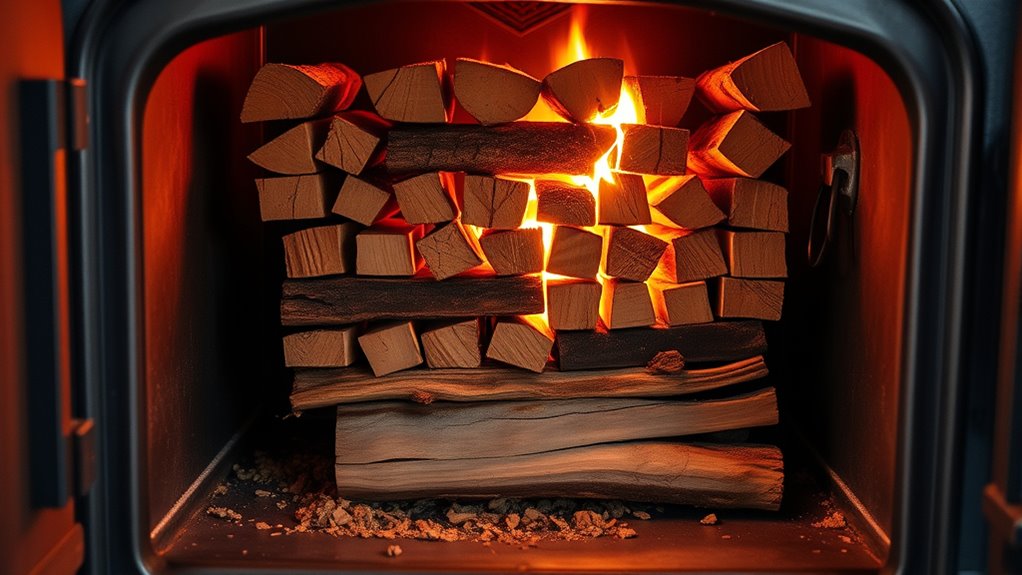
Building an effective fire structure is essential for guaranteeing your fire ignites quickly, burns evenly, and produces minimal smoke. Start by placing your fire grate at the bottom of the stove to improve airflow and support the fire. Use fire starters to ignite the base easily—these help get your fire going faster. Arrange your firewood in a way that promotes good combustion:
- Place larger logs at the bottom, leaning slightly for airflow.
- Stack smaller logs and kindling above, leaving space for air to circulate.
- Keep the fire starters in the center or underneath the kindling for easy ignition.
- Ensure the structure allows oxygen to flow freely, which promotes a steady burn and minimizes smoke. Proper airflow management is crucial for efficient combustion, ensuring your wood stove operates safely and effectively. A well-built fire structure maximizes heat and efficiency in your wood stove and supports proper airflow, which is crucial for efficient combustion. Additionally, understanding how effective fire-building techniques are based on proper airflow can help users learn optimal fire-building techniques more interactively. Recognizing the importance of performance tuning can also aid in maintaining your stove’s optimal operation over time.
Lighting the Fire Safely and Properly
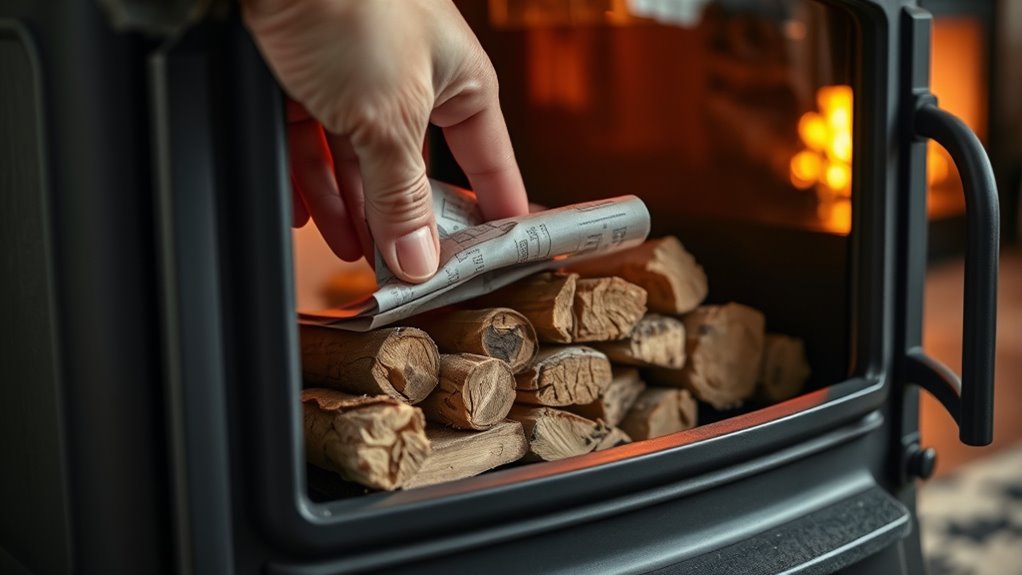
Lighting your fire safely and properly begins with ensuring good ventilation and clearing the area of any flammable materials. Before igniting, check that your chimney is clean to promote proper chimney safety and prevent dangerous creosote buildup. Use dry, seasoned wood and arrange your fire in a way that allows airflow. Here’s a visual to help you picture the setup:
| Dry Firewood | Flammable Materials | Ventilation Needed |
|---|---|---|
| Kindling | Paper or Cloth | Open Damper |
| Small Logs | Decorations | Clear Workspace |
| Firestarter | Loose Paper | Proper Airflow |
This setup reduces fire risks and enhances fire prevention, ensuring a safe, efficient start to your fire.
Managing the Burn for Maximum Efficiency
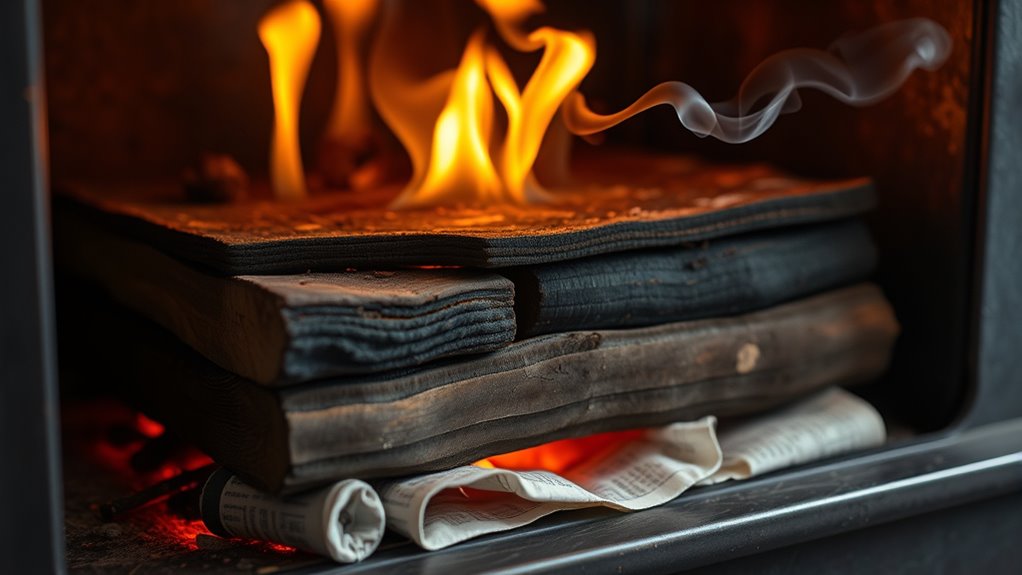
To get the most heat from your fire, you need to manage the burn carefully. Make sure you’re regulating airflow correctly to keep the fire roaring without wasting fuel. Using dry, seasoned wood will also help your stove burn cleaner and more efficiently. Additionally, maintaining awareness of the conflict resolution skills involved in managing the fire can help prevent flare-ups and ensure a steady, safe burn. Practicing proper fire safety procedures is also essential to prevent accidents and promote an efficient burn. Being aware of vetted safety guidelines can further support effective and secure operation of your wood stove. Incorporating best practices for fire management can enhance overall efficiency and safety during operation. Regularly monitoring the fire and adjusting your techniques based on fire management principles will ensure optimal performance and safety.
Regulate Airflow Properly
Properly regulating the airflow is essential for an efficient and safe burn in your wood stove. Good airflow control ensures the fire burns steadily and produces maximum heat while reducing smoke and creosote buildup. To manage draft regulation effectively: 1. Adjust the air vents or dampers to increase airflow for a hotter, faster burn. 2. Close the vents slightly once the fire is established to slow the burn and conserve fuel. 3. Keep the fire at a lively, steady glow—avoid smoldering flames or roaring fires. 4. Check for a consistent draft, ensuring fresh air enters and smoke exits smoothly. Additionally, understanding the importance of proper airflow control can significantly impact your stove’s efficiency and safety. Maintaining proper ventilation also helps prevent harmful buildup and ensures a cleaner burn. Incorporating sound healing science principles, such as ensuring a steady draft, can enhance combustion efficiency and safety. Ensuring the cybersecurity of your control systems can further protect against potential hazards and unauthorized access. Regularly inspecting and cleaning your stove’s components can help maintain optimal airflow, preventing blockages and ensuring consistent performance.
Use Dry, Seasoned Wood
Using dry, seasoned wood is essential for an efficient and clean fire. Proper firewood seasoning reduces moisture content, making your wood burn hotter and longer. When wood is wet or green, it produces more smoke and creosote, risking chimney buildup. To guarantee ideal combustion, select wood that’s been properly seasoned for at least 6-12 months. Check for cracks in the bark, a darkened color, and a weight that feels lighter than green wood. The table below evokes the difference seasoned wood makes:
| Fresh Wood | Seasoned Wood |
|---|---|
| High moisture content | Low moisture content |
| Produces more smoke | Burns cleaner |
| Difficult to ignite | Lights easily |
| Creates creosote buildup | Keeps chimney safer |
| Shorter burn time | Longer, more efficient burn |
Using properly seasoned wood also helps prevent outdoor fire hazards caused by excessive smoke and sparks. Proper ventilation and chimney maintenance are equally important for safety and efficiency.
Extinguishing the Fire and Maintaining Your Stove

When it’s time to put out your fire, using proper extinguishing techniques guarantees safety and prevents damage. Regular stove maintenance keeps your wood stove running efficiently and reduces the risk of problems. Paying attention to these steps helps you enjoy a safe, warm fire every time.
Proper Extinguishing Techniques
After your fire has burned down to manageable embers, it’s essential to extinguish it safely to prevent accidents or damage. Proper extinguishing techniques prioritize firefighter safety and ensure your stove remains safe for future use. Here are four key steps:
- Spread out the remaining embers using a poker to promote even cooling.
- Cover the ashes with a layer of ash or sand to smother any remaining flames.
- Use a fire extinguisher suitable for wood fires, like a Class A extinguisher, to further suppress any sparks.
- Never leave the stove unattended until you’re certain all embers are out and the stove is cool to the touch.
Following these steps helps prevent accidental fires and maintains safe stove operation.
Regular Stove Maintenance
Properly extinguishing the fire is just one part of maintaining your wood stove; regular upkeep guarantees it operates safely and efficiently over time. You should schedule chimney inspections annually to prevent creosote buildup, which can cause dangerous fires. Regular ash removal is essential—wait until the ashes are completely cool before scooping them out, and dispose of them safely. Keeping the firebox clean ensures better airflow and heat efficiency. Check the door gaskets periodically for leaks and replace them if they’re worn. Inspect the chimney for blockages or damage, and clean it as needed. Consistent maintenance not only prolongs your stove’s lifespan but also keeps your home safe and warm. Staying proactive with these tasks makes stove operation safer and more efficient.
Frequently Asked Questions
How Often Should I Clean My Wood Stove?
You should clean your wood stove regularly to guarantee safe and efficient operation. Aim for chimney maintenance and stove cleaning at least once a year, or more often if you use it heavily. Keep your wood storage dry and well-ventilated to reduce creosote buildup. Regular cleaning prevents chimney fires and maintains good airflow, so check your stove and chimney every few months, especially after heavy use or when you notice smoke or odors.
What Safety Precautions Should I Take During Startup?
You might find it surprising how often fire safety and proper ventilation overlap during startup. Always guarantee your stove is clear of debris, and check that vents are open for good airflow. Use dry, seasoned wood to reduce smoke, and never leave a fire unattended. Keep a fire extinguisher nearby, and make sure the room is well-ventilated to prevent carbon monoxide buildup, ensuring a safe and efficient start.
Can I Use Paper or Cardboard to Start the Fire?
You can use paper or cardboard to start your fire, but be cautious. Paper recycling is a good option because it burns cleanly and ignites easily. However, avoid burning cardboard that’s coated or printed, as it releases harmful chemicals. Cardboard burning should be done sparingly, and always guarantee proper ventilation. Using dry, untreated paper and plain cardboard helps create a safe, efficient start without risking stove damage or health hazards.
How Do I Prevent Creosote Buildup?
Coincidentally, preventing creosote buildup begins with regular chimney inspections, which catch deposits early. You should also store your firewood properly—dry, seasoned wood produces less creosote. When you build fires, maintain a hot, efficient burn by avoiding smoldering flames. These steps help keep your chimney clean, reduce fire hazards, and guarantee your stove operates safely and efficiently, making cozy fires worry-free.
What Should I Do if the Fire Won’T Stay Lit?
If your fire won’t stay lit, first check your fire starter options—try using crumpled newspaper or commercial firelighters. Next, guarantee proper airflow adjustment by opening vents slightly to improve oxygen flow. Avoid overloading the stove, which can smother the fire. If needed, add small, dry kindling gradually. Keep adjusting airflow until the fire burns steadily. With these steps, your fire should stay lit longer and burn more efficiently.
Conclusion
Remember, starting a fire in your wood stove is as much about patience as it is about technique. With the right supplies, a proper build, and safe practices, you’ll enjoy cozy warmth all season. Keep in mind the old saying, “A stitch in time saves nine”—taking a little extra care now guarantees your fire burns bright and efficient later. Stay attentive, and you’ll master this skill with confidence and ease.

